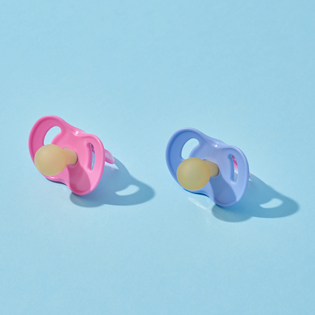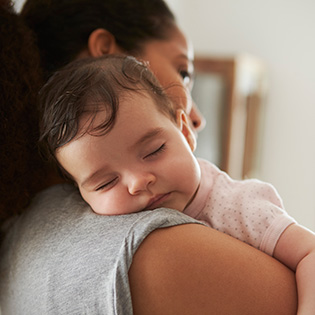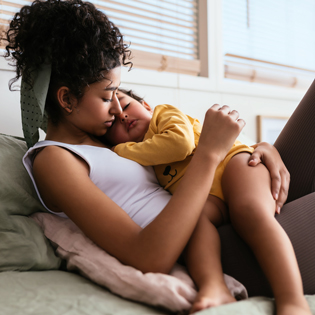Whether you’re headed to the park for a leisurely stroll or to Paris to see all of the sights, a stroller is a must-have for life on the go with baby. The right stroller not only gives baby a safe place to sit or snooze, but it also provides a place for you to stash all of those must-have essentials, from wipes and diapers to a change of clothes and an extra pacifier.
But finding the best stroller isn’t easy. The market is saturated with all different types of models and prices that vary widely from as little as $30 to upwards of thousands of dollars. So when you begin your hunt, first consider your budget. Then, think about how you plan to use your stroller to narrow down your options. Ask yourself some key questions, like: Where are you going to use it? Where are you going to store it? How many babies will be using it? And how much stuff do they have?
A basic lightweight umbrella stroller makes travel (and storage) easy, while high-function stroller systems boast helpful features like extra storage and snap-on bassinets or car seats. For some, a basic model for occasional use is perfectly suitable. For others, the splurge on a more advanced model is well worth it — even if it feels like a big investment. If you frequently take baby out and about or plan to have multiple kids, your stroller will likely get miles and years of use.
Before you purchase, don’t be afraid to try out your top choices. A trial run goes a long way in making sure it works for baby’s needs — and for the needs of other family members who will be pushing it, folding it and stowing their things within it along the way.
Recommended Reading
What are the different types of strollers?
There are six basic types of strollers:
- Full-sized stroller
- Lightweight or umbrella stroller
- Jogging stroller
- Double stroller
- Car seat carrier
- Travel system
It’s worth noting that although many strollers do fit squarely into the above categories, there are plenty that don’t. Some strollers can have characteristics of more than one type (i.e. a double jogging stroller).
Full-sized stroller
What it is: If you’re hoping to invest in one stroller that’ll wheel your baby right through the toddler years, look no further than a full-size stroller. Bigger, sturdier and usually more durable, these strollers are the standard option. Plus, many models come with a full range of features that not only make baby’s ride a joy, but also make your life easier.
Full-size stroller benefits: The go-to option for many families, a full-sized stroller covers all the basics and offers nifty bells and whistles that usually include:
- Wide, comfortable, well-padded seat
- Deep seat recline
- Option to mount the seat forward-facing or rear-facing
- Option to attach a car seat
- Convertible design that grows with baby, from newborn use with car seat (or optional bassinet, in some cases) to toddler use
- Expandable canopies
- Sturdy tires with decent suspension to absorb shock
- Roomy basket for storage
- Telescoping handlebars (especially helpful when one parent is tall and the other is petite)
- Useful nice-to-haves, like a cup holder or snack tray
Full-size stroller downsides:
- Can be bulky and heavy (if you take public transportation, climb stairways frequently, or navigate busy streets or small stores with your baby, this can make it tougher to travel with)
- May also be a tight fit for a small-space home with limited storage.
Options to consider: See our roundup of the best full-size baby strollers.
Lightweight or umbrella stroller
What it is: You might lose a few of the features you can find in a full-sized stroller, but an umbrella stroller scores points for being supremely easy to handle while on the go.
Lightweight or umbrella stroller benefits:
- Often weighing under 15 pounds, a lightweight stroller is designed for portability (some even come with a shoulder strap).
- These models are easy to fold, which makes stashing one in the trunk or taking it on an airplane, bus or train a snap.
- Many lightweight strollers still come equipped with beneficial features, such as a partial seat recline, expandable canopy, storage basket and built-in cupholder or snack tray.
Lightweight stroller downsides:
- If you’re looking for a stroller you can use from the newborn months on, a lightweight stroller won’t do. While a few models can safely carry newborns with car seat adapters or bassinet attachments, most umbrella strollers are designed for babies 6 months or older.
- Most lightweight strollers do not have a convertible option, which means if you end up having a second (or third) baby within a few years of your first, you'll likely need to purchase a second stroller.
Options to consider: See our roundup of the best lightweight umbrella strollers.
Jogging stroller
What it is: On the run — literally? Then a jogging stroller might be a good option. Jogging strollers typically have larger, sturdier wheels and better suspension to take bumps and alternate terrain in stride.
Jogging stroller benefits:
- Superior suspension lets you walk, jog or hike and keep baby in comfort while on and off the trail.
- Many jogging strollers come with a front wheel that can swivel (for flexibility) or be fixed (for stability at higher speeds).
- Depending on the model, other benefits may include compatibility with a car seat (for use from newborn through toddler stages), deep reclining seats, telescoping handlebars and generous storage baskets. A hand brake, five-point harness and wrist strap are key safety features, so don’t go jogging with a stroller that doesn’t include these.
Jogging stroller downsides:
- A jogging stroller can be a bit heavier and challenging to assemble.
- If space is tight, a jogging stroller usually can't fold up as small as an umbrella stroller.
- Jogging strollers are typically wider than even many full-size strollers, which means maneuvering them through tight spaces can be challenging.
Keep in mind that while most three-wheeled strollers are referred to as “joggers,” not all three-wheelers are actually optimized for runners. Some of the most popular three-wheelers are “hybrid” strollers that lack hand brakes and other safety features, and therefore, aren’t intended to be used for jogging with baby. Serious runners will want to do a test drive to make sure their jogging stroller has the appropriate safety features and functionality.
Options to consider: See our roundup of the best jogging strollers.
Double stroller
What it is: If you’ve got twins in tow — or a toddler who’s not ready to give up their stroller days — then a double stroller is the way to go. Doubles come in two formats: tandem, where one child sits behind the other, or side-by-side seating.
Double stroller benefits:
- With multiple children, this option enables you to swiftly manage only one stroller.
- Because these models are on the bigger side, there's usually ample storage space.
Double stroller downsides:
- Strollers for two tend to be bigger and bulkier, weighing in at up to 40 pounds and with a much larger footprint.
- Though there are some lighter options, these are not without issues, as they don’t tend to take bumps and alternate terrain well. As you shop, consider width (does it fit through your door?), mobility (is it well balanced? how does it turn?) and whether it’s compatible with one or two car seats.
Options to consider: See our roundup of the best double strollers.
Car seat carrier
What it is: These wheeled frames are built to transform your infant car seat into a stroller in just a snap (literally!).
Car seat carrier benefits:
- Car seat carriers are compact and lightweight.
- For a no-fuss transition into and out of the car, they are convenient and great for travel.
- Some car seat carriers can even accommodate multiple babies.
Car seat carrier downsides:
- Car seat carriers tend to be best for short-term use, since baby outgrows the infant car seat quickly. That said, some full-featured strollers function as a car seat frame, then transform into a toddler-friendly stroller.
- Car seat carriers generally do not have any extra features like cup holders or storage.
Travel system
What it is: An easy-to-connect travel system pairs together an infant car seat and stroller. There are full-size, lightweight and jogging stroller travel systems, so you can choose a system with the type of stroller you like best.
Travel system benefits:
- Having an infant car seat that connects to your stroller with an adapter (usually built in) means you can move your sleeping baby from the car to the stroller without waking her up.
- Being able to buy both components as a set may save you money.
Travel system downsides:
- While the stroller will usually last into the older toddler years, your baby will outgrow the infant car seat much sooner than that.
- If you’re a multiple-car family, you’ll need to buy a separate car seat or base to use with your second car.
Options to consider: See our roundup of the best travel system strollers.
What should I consider when buying a stroller?
A safe, reliable and easy-to-use stroller is a definite must-have. But as a stroller can range in price from $30 to upwards of thousands of dollars, you’re going to want to make sure you’re getting the best option for your dollar. These basic questions can help.
- Where will you use it? Many mid-range models can be big and bulky — not ideal if you’re navigating narrow city streets. But a smaller umbrella stroller might not work for you if you need a stroller basket big enough to handle your purse, diaper bag and other essentials. Know where you’ll go with your stroller — that’s half the battle.
- Is it newborn friendly? Check the details. Some strollers offer a deep recline or bassinet mode, which means you can put your newborn in them from day one — with no add-ons needed. But many models are more suitable for infants who have some neck control or can nearly sit up unsupported, which usually doesn’t happen until month 6. You may need to attach a car seat or optional bassinet to make some models infant-ready, so know what you’re getting before you buy.
- How long do you plan to use it? While you may pay more up front for certain models, adaptability from newborn through toddler stages could save you cash in the long run. Do you plan to use the same stroller for multiple kids? If so, shop for long-term value, and consider a model you can add onto — a car seat, a stand-and-ride bumper, or an additional seat for a new baby.
- How easy is it to use? Once you’ve done some research and narrowed down your choices, it’s smart to do a test drive in person, so you can see how your favorites compare — and consider that a flat and shiny store floor may not reveal how a particular model will do on uneven sidewalks or hilly terrain. Can you steer it smoothly? Can you maneuver it with one hand? How does it handle a tight turn?
- How easy is it to fold and unfold? You’ll likely be holding baby — and more — when you need to fold or unfold the stroller, so easier is better. Many models tout a one-hand fold, but try before you purchase — not all one-handed folds are as easy as they sound.
- How heavy is it? When you’re on the road, lighter is better. But note the details, because some manufacturers will call a 25-pound stroller lightweight, while others can weigh a mere 12 pounds. If you live in a city, for example, that can be a big difference when you’re carrying a baby, a diaper bag and a stroller up endless staircases or squishing onto the subway.
- Do you need more than one? Perhaps you'd prefer to have an umbrella stroller for the road, but a full-sized model for busy days in the neighborhood. For some families, one stroller just doesn’t cover all the bases, no matter how cleverly designed. If that’s the case, consider splitting your stroller budget rather than investing heavily in one. You might need a basic full-size model for home and a separate umbrella stroller for travel.
Helpful features to look for in a stroller
- Safety features: Above all else, make sure the stroller you have your eye on meets basic safety requirements.
- Quality wheels: You won’t log many miles with flimsy wheels — they get stuck on uneven terrain (including bumpy sidewalks) and are more prone to snapping.
- Sun canopy: Look for long or adjustable canopies to keep baby shielded from sun, rain and other elements. Some models even have ventilated or clear windows, so you can protect baby, but still keep a close eye on her.
- Storage: Babies come with a lot of gear. A stroller with a large undercarriage to hold items will make your life much easier on the go.
- Washable fabric: It’s no secret that babies are messy. Combine baby’s messes — snack crumbs and snot, for instance — with regular wear and tear, and your stroller will certainly take a beating. A model with easy-to-wash fabric will help you keep your stroller in good shape for longer.
- Longevity: To get the most bang for your buck, look for a stroller that will grow with baby — and possibly beyond, if you choose to add additional children to your brood.
Choosing the right stroller for your family
Before deciding on a stroller, it’s important to consider three things: cost, lifestyle and family size.
- Cost: As previously mentioned, stroller prices vary wildly. And while top dollar models do often have plenty of added convenience features — adjustable handlebars, rain shields, large undercarriages and even multiple seats — they aren’t always necessary.
- Lifestyle: This is where lifestyle comes in. Do you anticipate heavy near-daily use? Or do you need a stroller simply for occasional outings? Other lifestyle factors to consider: Can you transport your stroller via the car? Or, will you be lugging it through the city, up subway stairs and in and out of apartments? Answering these types of questions can help you figure out whether you should gravitate towards more basic, lightweight models — or if you can swing a heavier model with all of the bells and whistles.
- Family size: Finally, consider your ideal family size. If you ultimately plan to have more than one child, it often makes sense to make a larger investment on a model that can eventually accomodate more children. Though you’ll have to be able to stomach the bigger price tag now, it’ll ultimately save you from having to buy more than one stroller.
How do I make sure my stroller is safe?
When it comes to hitting the pavement with baby, safety comes first. Almost all stroller models these days meet basic safety standards, but there are a few additional safety features to consider when you’re stroller shopping.
- Look for a five-point safety harness. Five-point harnesses are relatively standard these days, but some umbrella strollers may skimp with a three-point harness. Test the snaps to make sure they’re secure and easy to buckle (and not too easy to unbuckle — at least for baby!).
- Put on the brakes — literally. Be sure to test how easy the brakes are to use — and how easy they are to trip, too. Do you find yourself hitting the brakes when you don’t intend to? Do the brakes offer a secure stop? Can you easily disengage the brakes when you’re ready to roll on?
- Examine the hinges and edges. Nooks and crannies on any baby product can be tricky, but be especially careful when looking at strollers. Little fingers and toes can get caught in tight spaces, so beware of any protrusions or sharp edges.
- Get some shade. A stroller shade or canopy is a must for walks in the sun (or rain) — consider opting for a model with built-in SPF protection, too.
- Can baby lie back and relax? How deep does the seat recline? If you’re planning to put a newborn into the stroller, look for models that offer a flat recline or bassinet attachment.
- Put all the pieces together. If you’re planning to purchase a travel system, look at the safety ratings for the car seat, and check out how the car seat attaches to the stroller. Is it an easy-to-use, one-click system? Are there a lot of straps or an adapter involved? You want it to be as simple and straightforward as possible (babies are complicated enough!).
Register your stroller as soon as you buy it. This will keep you in the loop if there’s ever a recall — information you’ll want to act on immediately.











































 Trending On What to Expect
Trending On What to Expect







